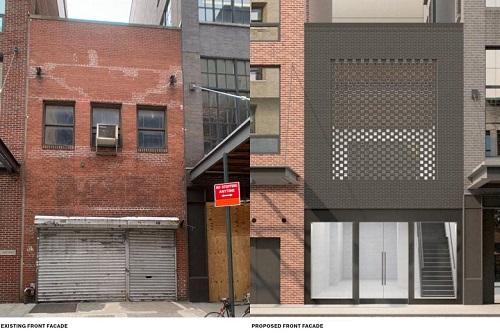 Tuesday, April 23, 2024
Tuesday, April 23, 2024  Tuesday, April 23, 2024
Tuesday, April 23, 2024 
The building was two stories, brick without detail, three small windows over a metal roll-up garage gate—an eyesore if there ever was one, crammed between two taller neighbors. The proposed replacement was in gray brick, the creaky gate swapped for a glass-and-metal storefront, the windows making way for a delicate brick screen, to let the light in. Let your own eyes judge:
This is what the New York City Landmarks Preservation Commission thought: The old brick building, said commissioner and architect Michael Goldblum, “is very much reflective of the period of significance of the district.” And the new building’s design, “while appropriate in scope, needs to be examined and made more location-specific … that’s not a very tangible direction, but I think it’s something the applicants can think about.” Sorry: The architects would have to try again.
Everyone knows there’s no arguing about taste. What the past half-century of urban growth in the United States presupposes is: What if there is? The promotion of good design in new buildings—distinct from the idea of preserving old ones—has become as much a local government objective as making sure every kid has a seat in school. Older American cities and suburbs are blanketed with zoning codes, historic districts, and design commissions that make sure communities that look nice stay looking nice.
A new wave of housing activists argues that this focus is a farce. In reality, they say, the ostensible interest in cornices, mullions, materials, rooflines, massing, and setbacks on new buildings serves as a convenient excuse for neighborhoods to keep everything the same—except for the socioeconomic diversity that once filled their sidewalks. Buildings that do survive the pageant arrive in a diminished state, bearing high rents that testify to their long delay and small stature.
“Time is money,” says Diana Lind, the author of Brave New Home, which argues against the single-family-home paradigm that keeps density out of expensive neighborhoods. “It’s the basic issue for most developers: Housing cost is only partly labor and materials. A lot of it is time and risk. Developers will talk about having an entire year to start building and factoring that into their cost.” In other words: Housing is more expensive, and less abundant, in the name of good looks. Not everywhere, but often in the high-opportunity neighborhoods and cities where it would mean the most.
It is hard to pinpoint what America’s era of highly supervised construction has achieved. This status quo has preserved the shape of older places, but not the kinds of people who once lived there. Instead we’ve manifested a landscape of historicist McMansions, parking podium towers, isolated commercial buildings dressed up in ornament like children on Halloween, landmarked gas stations and shoe-repair shops, and mishmash structures drafted by committee. This hyperlocal futzing is part of the reason that, in the decade following the Great Recession, we built the fewest new homes per capita of any period since World War II.